What is Rising Damp?
Rising damp is moisture present in your walls as a result of water in the ground underneath or next to your walls rising up through the fabric of the wall, whether it be brick, block or stone.
The water travels upwards through the wall as a result of capillary action (where water is sucked through a small opening such as a tube or hole) through the tiny holes in the brick or stone.
The water then stops rising at a height where gravity counteracts the upwards force of the capillary action.
This ‘rising damp’ usually reaches a maximum height of 1.2m, but the effects of the damp, such as salt deposits, may be seen higher up due to the presence of non-breathing wall coverings such as vinyl wallpaper and non breathing plasters, renders and paints.
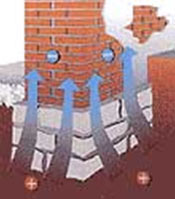
How rising damp can rise up from the ground and on up into your walls
What are the Signs of Rising Damp?
Typical signs of rising damp rather than other damp problems are a ‘tide line’ of yellowish or brownish staining or blown plaster in the lower area of your wall above your skirting board. You also might have damp or rotting skirting boards or flooring.
You may see white, fluffy deposits in your plaster – these are ‘salts’ which the damp has washed out of your bricks and into your plaster. Black spots of mould may also appear on on the damp areas of your wall.
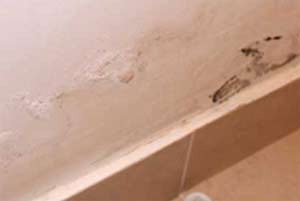
A yellow or brown ‘tide line’ above your skirting board is one of the signs that you may have rising damp in your walls
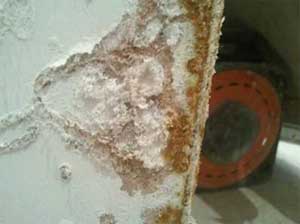
As damp evaporates from your walls it can leave salt deposits behind – these are another sign that you have a damp issue
What Causes Rising Damp?
Rising damp problems often occur as a result of not having a Damp Proof Course installed or having a Damp Proof Course that is faulty due to age or inadequate installation.
A Damp Proof Course is a waterproof layer in your wall (or both walls if you have a cavity wall), ideally about six inches from the outside ground on your external wall and under your raised timber floor or near your concrete floor on your internal wall (so both DPC’s are on the same level).
This layer repels water – a variety of different DPC’s are available and will be discussed in this project.
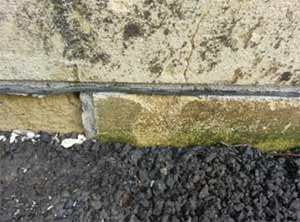
A damp proof course will stop rising damp from rising up into your walls – it is a waterproof layer that sits between your bricks across your house
You may be experiencing rising damp even if your Damp Proof Course is functioning well – in this case the DPC may be breached, that is, there may be something attached to your walls that is allowing water to travel around the Damp Proof Course and continue moving upwards.
It may be that there is an area of ground next to your external wall that is higher than your DPC, or there is an outside structure (such as steps) which is attached above the DPC, allowing water to travel up through this and cross to the wall over the DPC.
There are several other ways your DPC might be bridged by the fact that your internal plaster may be directly connected to a solid floor at the bottom on your internal wall.
Your cavity wall may also have debris inside of it, whether it is leftover building materials or something else.
If this debris reaches above the DPC’s then this can create another bridge for moisture to travel from the ground over the DPC and up your wall as rising damp.

Rising damp can happen as a result of debris present in your cavity wall bridging the Damp Proof Course and giving water a way to travel around the DPC and up into your walls
Remember that your damp problem may not necessarily be caused by rising damp as there may be another source of water that you are not aware of.
A telltale sign that your damp is not rising damp is if the damp patches are higher up than 1 metre on your wall and are unevenly distributed, in which case you may be suffering from penetrating dampness instead.
To be sure that rising damp is the issue you’re facing, take a look at our other project page Damp Diagnosing and Analysing project page.
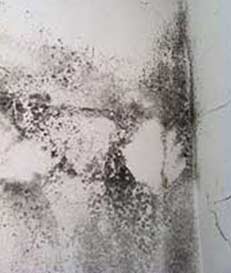
Uneven damp patches higher on your wall than 1.2 metres may mean that you have penetrating dampness in your walls instead of rising damp
How Can I Find Out What is Causing my Rising Damp?
You should first check that you have a Damp Proof Course – this will usually be visible outside your house as a line 6 inches above the ground.
If you do have a DPC, check that there are no structures bridging it.
Examples include higher outside ground or outside steps that are higher than your DPC and internal plaster that directly meets a solid floor.
The rising damp could also be coming in from a neighbour’s property if they don’t have a DPC or their DPC is higher up than yours, allowing the damp to travel around your DPC.
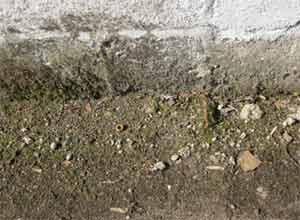
If you do not have a damp proof course or it is bridged or below ground level this could be causing your rising damp problem
As mentioned earlier, your DPC may also be bridged internally. This happens when your cavity wall becomes filled with debris, which can happen during the building of your house.
This can reach higher than the level of the DPC, allowing water to travel up it and over the DPC, then it can travel, via the bridging material, through the wall to the inside.
You can check for this by removing some of the bricks on your external wall (don’t remove more than two bricks without consulting a tradesman or surveyor). Using a phone with a light or a camera, take a look around the cavity.
If there is debris there, you can take this out by hand if you can reach it (use sturdy gloves to avoid injuring yourself on sharp objects) and use a bar to drag any out of reach objects closer to you.
To get smaller bits and dust out, use an old vacuum cleaner. Once the cavity area you have access to is clear, replace your bricks.
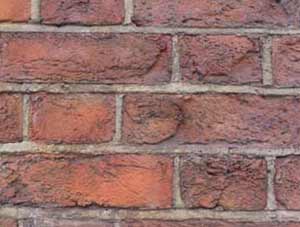
Brick wall with brick faces blown off
Treating Rising Damp
As with all projects on DIY Doctor, we don’t recommend that you deal with the effects of a problem without first tackling the cause.
You need to identify the cause, deal with it and then carry out the necessary repairs to deal with the effects.
Carrying out a quick-fix for rising damp, (e.g. repointing or painting over the damp) will just make the job more expensive in the long term and will mean you need to do the job all over again at a later date.
If you’ve established that your rising damp is caused by a blocked cavity wall, unblock your cavity as described in the section above.
If you know that your Damp Proof Course is bridged in another way such as by high outside ground, try to remove or adjust whatever’s causing the bridge so that it only reaches below the DPC.
Solutions include digging a trench that’s six inches deep by your house if your Damp Proof Course is buried in the ground currently. In this case, make sure that water doesn’t pool in the ditch you’ve created, as this will cause its own damp problems.
If you can’t remove the object breaching your DPC or you have an absent or faulty DPC, the best way of treating your rising damp is to damp proof. In other words, to install a new Damp Proof Course in your walls.
This can be the first DPC your house has had or installing one above your existing one if you have a structure breaching the current DPC that you can’t move.
You can try to ‘top up’ an existing damp proof course but this isn’t advised as you need a continuous waterproof layer without breaks and this fix doesn’t guarantee that, meaning that you could quite possibly be wasting your time.
A damp proof course is a waterproof barrier that spans the width and length of your wall.
It stops water from the ground rising up through the wall through capillary action. The DPC needs to be installed at least six inches above ground level according to British Standard 6576 and Building Regulations also state it should be at this height.
DPC’s come in a variety of different forms, from sheet materials such as plastic through to chemical formulations.
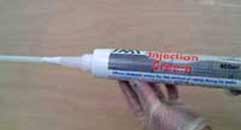
Chemical formulation Damp Proof Courses are installed in liquid form – a popular choice for DIYers
Dealing with Damp – The Different Types of Damp Proof Course
When houses are built with a DPC the builders will usually fit a sheet Damp Proof Course made from stainless steel or plastic – it’s obviously harder to do this once the house is built, though you can vibrate stainless steel sheet into your walls using saw cut slots if you want to – this will however need to be done by a tradesman.
There are plenty of easier retrofit DPC options available – these include:
- Water repellent chemicals – These are creams, gels or pastes that need to be injected, which are suitable for DIY and professional use on all types of wall
- Pore blocking salt mixture – This is a cement based mortar, which again needs to be injected and is mostly suitable for professional use and only on stone walls
- Osmotic water repellence – This can be passive or active and is done via embedded wires and is mostly suitable for professional use only
The easiest method for DIYers is to use a chemical formulation DPC that is simply injected into pre-drilled holes in the wall. Everything you need to know about injecting a damp proof course can be seen in our project here.
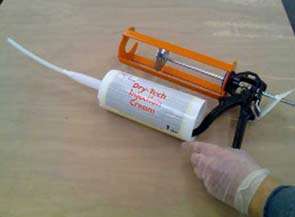
A chemical cream DPC is one of the easiest and best DIY damp proof treatment solutions
How to Install Your Damp Proof Course to Stop Rising Damp
Whichever method you choose to use, you will need to install your DPC on both your internal and external walls if you have a cavity wall.
The level at which the DPC is installed needs to be at least 6 inches above the level of your outside ground and at the same level on your inside wall.
If your outside ground level is higher than your internal floor level, you need to make a trench in your ground by your external wall deep enough that your DPC can be level with your concrete floor or under your raised timber floor inside.
If this is not possible, you will need to install the internal DPC above your floor level so that it is level with the outside DPC, which means that you will need to tank (waterproof) your internal wall below the DPC line to minimise any water ingress in that area.
When you come to install your DPC, however your walls are configured, you will need to remove any skirting boards and the plaster on your internal walls up from your floor level to where you want to install your DPC.
The easiest and most practical DIY rising damp treatment to use in your DPC installation is, as we’ve mentioned, the chemical water repellent DPC available as a liquid, cream, gel or paste.
Water Repellent Chemical Formulations
- You will need to drill holes between 10 and 12mm diameter into your wall, either in the mortar, brick or stone
- Drill the external and internal walls separately or in one go by drilling across the cavity from the outside if you have a cavity wall
- Read your DPC liquid/cream’s specific instructions to decide this and your drilling pattern, as well as whether your wall needs to be damp for the liquid/cream to work
- Inject the solution using a high pressure pump for liquid formulations or a low pressure hand operated skeleton gun or manual pump for cream, gel and paste formulations. The chemicals in the solution travel through the damp wall over a few months to form a water repellent layer. Because this barrier stops any more water from rising above it, this allows your wall above the DPC to dry out and stay dry
- Fill the holes you have made in your walls with a mortar into which you have mixed a water proofer – this adds an extra layer of waterproofing and means that the wall’s finish is returned almost to how it looked before the holes were created
- Make sure you allow your mortar to dry out properly before treating the wall for any salt deposits and replastering if necessary. This method is quick, neat and easy, with the resulting DPC being barely visible
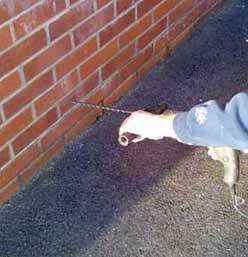
First, drill holes that are 10-12mm in diameter – varying this according to the DPC manufacturers’ instructions
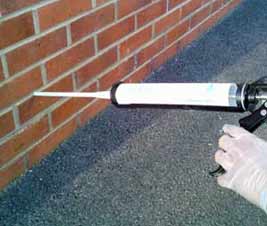
Fill the holes with a chemical formulation DPC – this is a cream/paste/gel being used with a skeleton gun
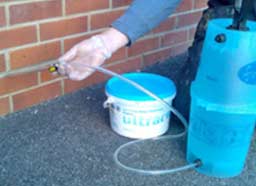
You can also use a hand pump to pump in your chemical formulation Damp Proof Course
Pore Blocking Salt Mixture
- Drill holes 18-20mm diameter in your walls, and as such this method is only really suitable for stable, thick stone walls
- Mix the cement based mortar with water to make a slurry and use a plastic heavy duty injection ‘gun’ to inject this into the holes. The mortar sets, giving off lots of heat, and forms a series of solid plugs in your wall. These mortar plugs release water repellent salts which over a few months travel through the wall and block your masonry’s pores, preventing any damp from rising. This technique calls for the use of mortar guns and expensive, large drilling equipment so it only makes economic sense for a professional builder to use this method to install a Damp Proof Course
Osmotic Water Repellence
Old versions of this system used wires that were prone to corrosion, but the new Lectros Active System uses titanium wire linked to a transformer and a mains supplied control unit.
The wire is run around the walls like a ring main. Again, holes are drilled in the wall, either externally, internally or both.
The wire is bent into loops to create anodes, and these loops are inserted into the holes. The wire is then hidden in raked out mortar joints or specially carved out ‘chases’ and the wire is earthed.
The wire is secured in the holes and the chases with a special mortar that increases the conductivity of the system.
When the system is switched on, electricity passes through the transformer and the anodes and to earth, which sets up an electric field that repels water.
This technique again requires expensive and large drilling equipment and so is only really economical for tradesmen.
How to Repair Your Walls After Treating Rising Damp
Now you’ve sorted the cause of your rising damp, you can move on to tackling any repairs you need to carry out on any parts of your home’s interior that have been affected by the damp.
If your plaster is stained but sound you may be able to redecorate without replastering, but you should check that the plaster is dry (or leave it to dry) before doing so and check that the walls don’t have any mould or salt buildup caused by the damp.
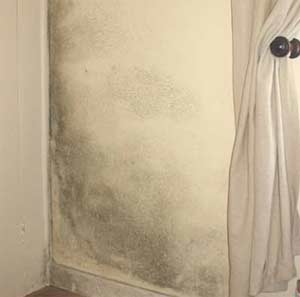
Once you’ve treated your rising damp, check that your plaster is sound, and if it is, check your walls for mould and salt deposits as you will need to treat these before redecorating
The mould will present as black spots – if the plaster is still sound you can treat it with Anti-Mould Cleaner and then an Anti-Mould paint or add an Anti-Mould Additive to your wallpaper paste when you redecorate.
If the mould or damp has stained your wall you can paint the surface with a stain blocking primer before redecorating to minimise this.
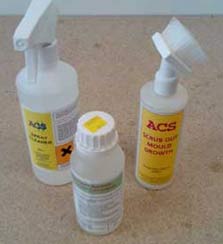
Treat any mould caused by your rising damp with an anti-mould cleaner
Salts build up on the wall as a result of the salts in the brick being drawn out of them by the damp and into the plaster, where they form fluffy white deposits.
As long as the ‘salts’ haven’t structurally damaged the plaster too much you can just treat your walls using a salt neutraliser before redecorating. Just paint the salt neutraliser on and wait for it to dry before redecorating.

Apply a salt neutraliser to make sure that salts don’t reappear on your walls
If the plaster isn’t sound any more, strip off your plaster to 30cm above the highest damp point on the wall. Use the back of your hand or a damp meter to determine this.
When you’ve stripped your plaster off you have three options for replastering to prevent future salt and mould appearances.
You can either brush the wall down, apply your Anti-Mould cleaner or Salt Neutraliser and then replaster, use your salt neutraliser and anti-mould cleaner and fit a mesh membrane before replastering, or you can add a breathable, waterproof render to your wall before replastering.
You also have different options for your salt neutraliser. You can either paint it directly onto the wall, replaster using a plaster that contains salt neutraliser already or add your salt neutraliser to your plaster mix.
Look for a neutraliser that you can apply in the way you want to and always follow the manufacturer’s instructions.
You can find more information on how to fit a mesh membrane to your wall in our How to Install a Mesh Membrane DIY Project.
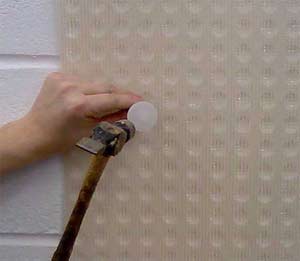
Fit a mesh membrane to your wall to ensure that salts don’t reappear in your plaster in the future
To add the render, brush any residue off the walls and fill any holes and cracks using a 4:1 mix of washed, sharp plastering sand and cement.
If your walls are made from a non-porous material such as granite you’ll need an adhesive to stick the render to the wall.
Dampen the walls a little and apply your render at a half-inch thickness maximum – your render should be 3:1 washed, sharp plastering sand and fresh Portland cement mixed with 1:40 Renderproof waterproofer and water.
Make plenty of scratches in the damp render surface using a trowel. When this layer is solid without being dry, add a second layer in exactly the same way.
You can add multiple layers until you have reached the thickness you want. While it’s damp add a skim coat of Board-Finish or Multi-Finish plaster – don’t add water or polish it.
Wait a month to decorate with a thin layer of breathable (not vinyl) emulsion if desired. In about three months time you should be able to repaint or wallpaper the wall.
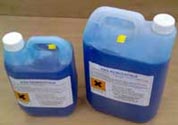
Use a waterproofing agent such as Renderproof to make a breathable waterproof render for your walls that you apply after treating your damp and before you replaster
You can confirm that a render or other waterproofing product you are buying is of good quality by checking that it meets the British Board of Agrément’s standards over on their website.

